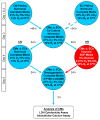Role of Nitric Oxide in Cardioprotection by Poloxamer 188
- PMID: 40643522
- PMCID: PMC12248624
- DOI: 10.3390/cells14131001
Role of Nitric Oxide in Cardioprotection by Poloxamer 188
Abstract
Poloxamer (P) 188 attenuates myocardial ischemia/reperfusion injury through cell membrane stabilization. Cell-cell interactions between endothelial cells (ECs) and cardiomyocytes (CMs) further protect CMs: co-cultures showed that, at an optimal density, ECs protected CMs against hypoxia/reoxygenation (HR) injury. The mechanism of interaction with P188 still requires exploration. We examined if N(ω)-nitro-L-arginine methyl ester (LNAME), a non-specific nitric oxide (NO) synthase inhibitor, abolishes protection in the presence or absence of P188 and/or ECs. We co-cultured mouse coronary artery ECs in an insert atop mouse CMs plated at confluency on the bottom of a well. Normoxic controls remained in complete media while HR groups were exposed to 24 h hypoxia at 0.01% O2 in serum- and glucose-free media, followed by 2 h reoxygenation in complete media. P188 (300 μM), LNAME (40 mM), or vehicle were administered upon reoxygenation. ECs at the used lower density did not decrease HR-triggered lactate dehydrogenase release or calcium overload in CMs by themselves. P188 reduced both indicators after HR by 16/18% without and by 22/25% with ECs, respectively. LNAME abrogated CM protection by P188. Neither intervention had an effect under normoxia. Our co-culture data indicates that P188 requires NO, not necessarily of endothelial origin, to elicit CM protection.
Keywords: NO; P188; calcium; cardiomyocyte; co-culture; co-polymer; cross-talk; endothelium; hypoxia reoxygenation; lactate dehydrogenase.
Conflict of interest statement
The authors declare no conflicts of interest.
Figures



Similar articles
-
Cardioprotection by poloxamer 188 is mediated through increased endothelial nitric oxide production.Sci Rep. 2025 Apr 30;15(1):15170. doi: 10.1038/s41598-025-97079-z. Sci Rep. 2025. PMID: 40307302 Free PMC article.
-
Electronic cigarettes for smoking cessation.Cochrane Database Syst Rev. 2022 Nov 17;11(11):CD010216. doi: 10.1002/14651858.CD010216.pub7. Cochrane Database Syst Rev. 2022. Update in: Cochrane Database Syst Rev. 2024 Jan 8;1:CD010216. doi: 10.1002/14651858.CD010216.pub8. PMID: 36384212 Free PMC article. Updated.
-
Electronic cigarettes for smoking cessation.Cochrane Database Syst Rev. 2021 Sep 14;9(9):CD010216. doi: 10.1002/14651858.CD010216.pub6. Cochrane Database Syst Rev. 2021. Update in: Cochrane Database Syst Rev. 2022 Nov 17;11:CD010216. doi: 10.1002/14651858.CD010216.pub7. PMID: 34519354 Free PMC article. Updated.
-
Mir221- and Mir222-enriched adsc-exosomes mitigate PM exposure-exacerbated cardiac ischemia-reperfusion injury through the modulation of the BNIP3-MAP1LC3B-BBC3/PUMA pathway.Autophagy. 2025 Feb;21(2):374-393. doi: 10.1080/15548627.2024.2395799. Epub 2024 Sep 8. Autophagy. 2025. PMID: 39245438 Free PMC article.
-
Cardioprotection Through Pharmacological Activation of Sirtuin 5 in a Murine Model of Acute Myocardial Infarction.Drug Des Devel Ther. 2025 Jun 27;19:5489-5505. doi: 10.2147/DDDT.S509337. eCollection 2025. Drug Des Devel Ther. 2025. PMID: 40606000 Free PMC article.
References
MeSH terms
Substances
Grants and funding
LinkOut - more resources
Full Text Sources

